Obsidian as a Second Brain
Table of Contents
Another Brain? #
In today’s digital age, the influx of new information is relentless. Every day, we are bombarded with articles, podcasts, books, videos, and more. Like most people, I used to forget the vast majority of information I wanted to retain — until I tried using Obsidian as a second brain.
A “second brain” is an external system for capturing and storing information that you can easily refer back to. It functions as a personal knowledge base where ideas and notes are systematically organised and easily accessible, helping to offload cognitive load from your brain, and improve focus and creativity. With a second brain, you don’t have to rely solely on your memory to recall information. Instead, you have a well-organised system that you can trust.
Building a second brain is closely related to the topic of Personal Knowledge Management (PKM) systems. While the focus of a PKM system is on organising and managing knowledge efficiently, a second brain focuses on building a dynamic personal knowledge repository that is highly interconnected. This means using links to connect related notes and ideas and then reviewing the interconnected web of notes to gain new insights and ideas. By exploring how concepts relate and contrast with each other, we gain a much better understanding of underlying ideas than if we simply categorise them in folders. This creates a web of knowledge that mimics the way our brains naturally process information.
Why Obsidian? #
“OK, that sounds interesting. But why Obsidian over (insert other note-taking app)?” These are the key reasons that convinced me to give it a try:
-
Local Storage: Notes are stored locally on your device instead of in a proprietary database. In today’s cloud-focused world, it’s increasingly difficult to own your content. With Obsidian, files are saved on your device, giving you privacy and actual control over your data. Local storage also means you can access your notes even without an internet connection—essential for subway rides and flights.
-
Markdown Support: Notes are written in plain text Markdown, meaning you can create notes without worrying about formatting distractions. Combined with the local storage feature, it also means your Obsidian repository is simply a folder of Markdown files on your device. If you ever get tired of Obsidian, you can still easily access and edit your files with any other text editor. Not being permanently tied to Obsidian is one of its best features, as you know you can preserve your data for the long term.
-
Linking and Backlinking: Notes can be bidirectionally linked to create a web of interconnected ideas. As mentioned earlier, this is a crucial requirement for a second brain. Obsidian makes this process very easy - you just enter the name of a note you want to link to the current note between square brackets.
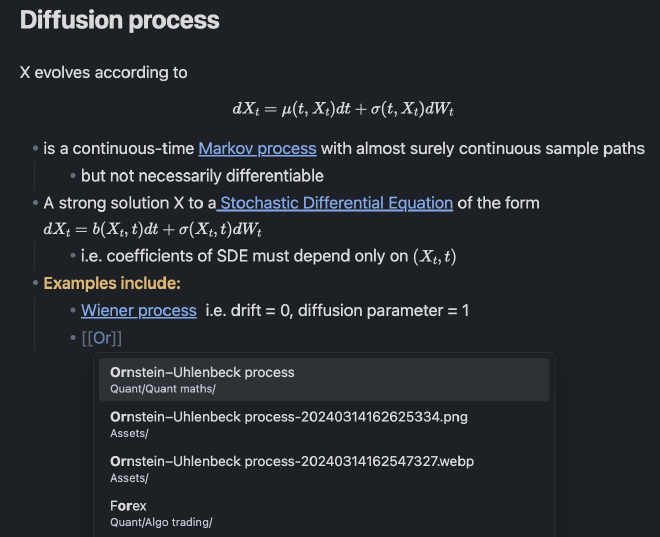
- Graph View Obsidian provides a visual representation of the connections between notes through the graph view, allowing you to explore relationships in your knowledge. It’s like having a mind map that grows organically as you add more notes.
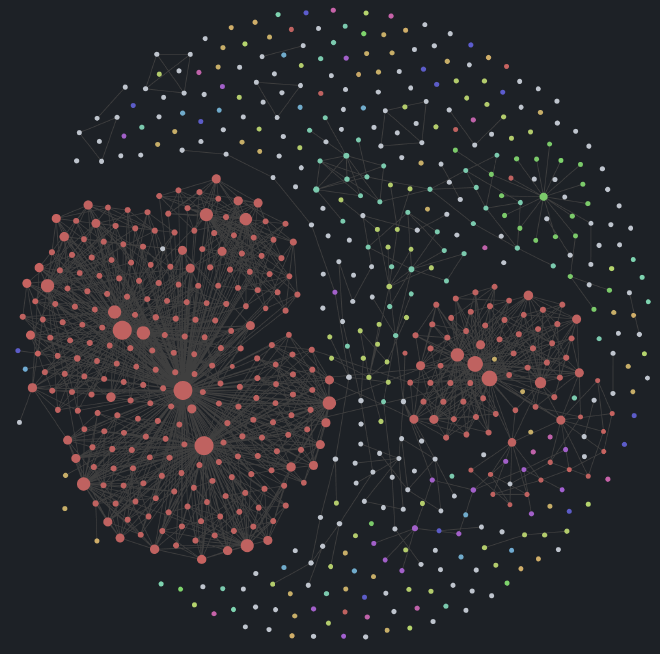
- It’s Free: Obsidian is completely free to use on any device. While Obsidian does offer a paid syncing feature to edit notes from any of your devices, you can achieve the same setup for free with some tinkering.
Community Plugins #
What really allows Obsidian to stand out is its community plugins. From task management to advanced graph visualisations, there’s likely a plugin that fits your needs. Some of the plugins I use include:
Templater - defines a templating language that lets you insert variables and function results into your notes. It will also let you execute JavaScript code manipulating those variables and functions. The main purpose I have used Templater for is having daily, weekly and monthly notes that are autogenerated and connected to one another in smart ways. See this post for details on how I use Obsidian for journalling, habit tracking, goal management and more.
Dataview: Lets you treat your Obsidian Vault as a database which you can query from by providing a query language for filtering, sorting, and extracting data from Markdown pages. For example, my monthly note template has a query which automatically collates all entries I have tagged with “Learning::” in my daily notes for that month
TABLE WITHOUT ID file.day.weekyear AS Week, learning
FROM "Journal/Daily"
WHERE learning != null
AND file.day.year = number(substring(this.file.name, 0, 4))
AND dateformat(date(file.name), "yyyy-MM") = replace(this.file.name, "M", "")
SORT file.day
Calendar: Integrates a calendar view into your notes for easy navigation between your daily and weekly notes
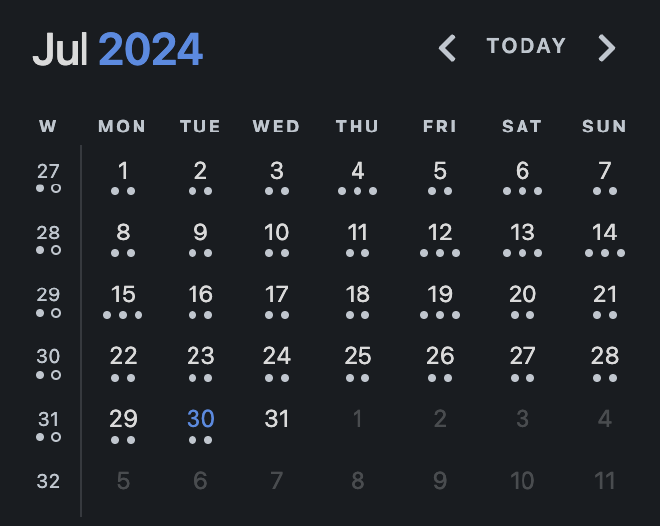
DB Folder: allows you to create Notion like databases in your Obsidian Vault. This allows you to view and edit the metadata of your notes without having to open them directly. Perfect for habit tracking!

Charts: lets you create interactive charts inside Obsidian - again, see this post for more details on how I use this.
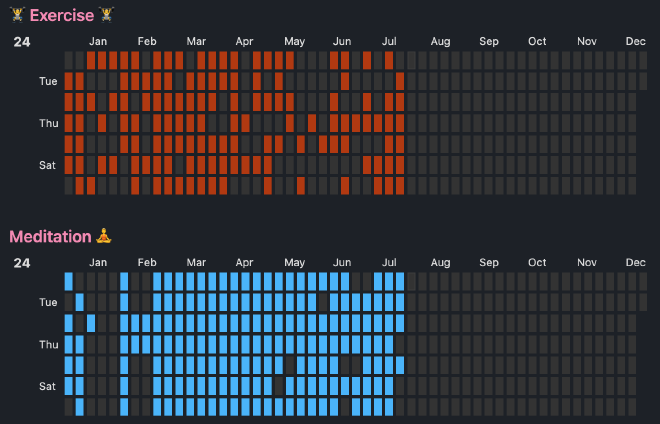
Omnisearch: a search engine that helps you find the most relevant notes in your vault, thanks to its smart weighting algorithm
Obsidian Kindle Plugin: sync your Kindle notes and highlights directly into your Obsidian vault. Allows you to parse and render the highlights into a template that you can configure. I have set my highlights to come through with a “Kindle::” tag so that I can populate my daily notes with some random highlights every day.
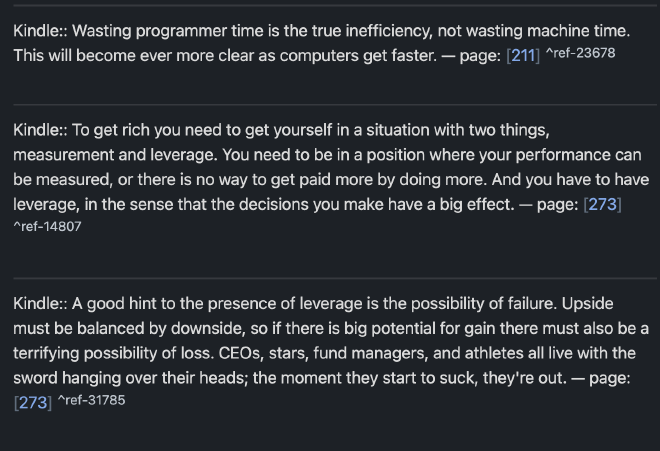
Omnivore plugin: sync highlights from Omnivore (my favourite read it later app for articles and blog posts) into Obsidian
Zotero plugin: sync notes and highlights from Zotero (my favourite pdf reader for textbooks) into Obsidian
Todoist plugin: allows your Todoist tasks to sync bidirectionally with Obsidian. This lets me see my daily todo list directly from my daily Obsidian note
Obsidian to Anki plugin: add flashcards to Anki directly from Obsidian
Any problems? #
Of course, no tool is without its quirks, and Obsidian is no exception. The learning curve can be a bit steep, especially if you’re trying to automate complex templates. Also, the flexibility of Obsidian means there’s no one right way to use it, which can be both liberating and overwhelming. It took me a while to find a system that worked for me, and I’m still tweaking it as I go.
Conclusion: A Tool for the Knowledge Age #
In the end, Obsidian has become an indispensable part of my daily routine. It’s not just a tool for storing information; it’s a catalyst for learning, creativity, and productivity. By turning my notes into a living network of ideas, Obsidian has transformed the way I engage with information.
If you’re looking for a way to manage the deluge of information in your life, I highly recommend giving Obsidian a try. It might just change the way you think, learn, and create.